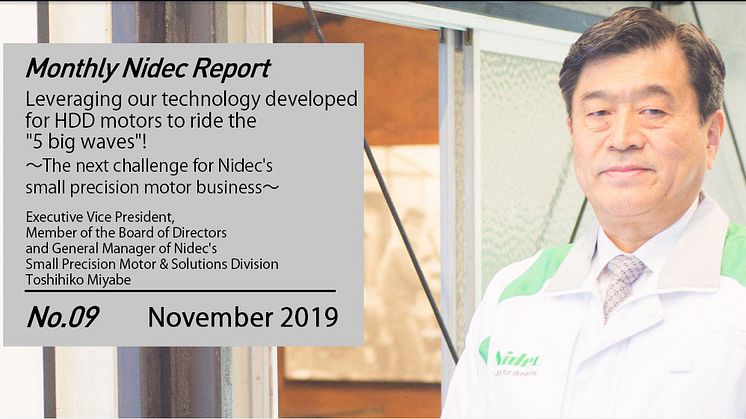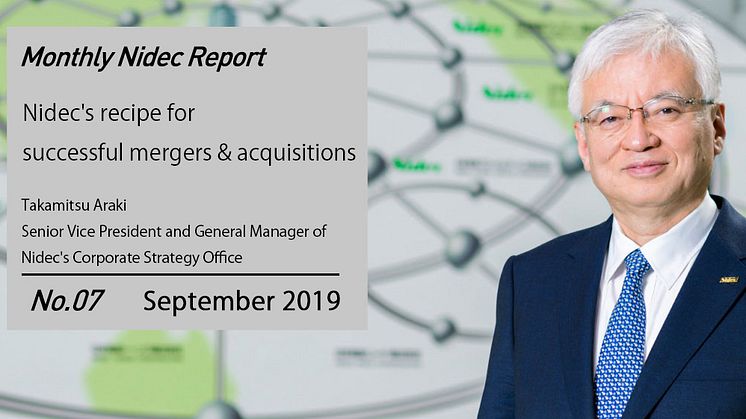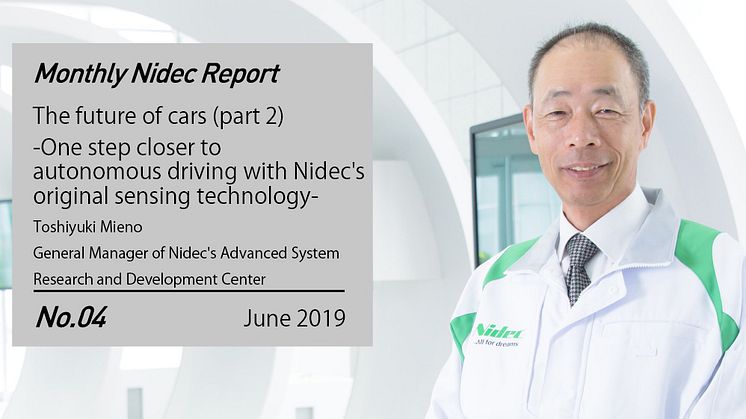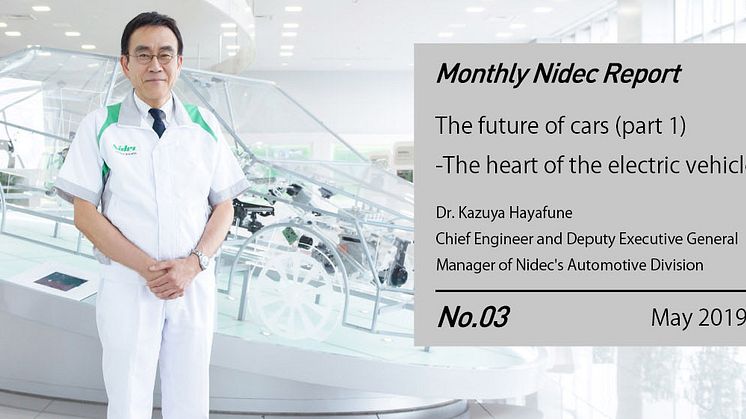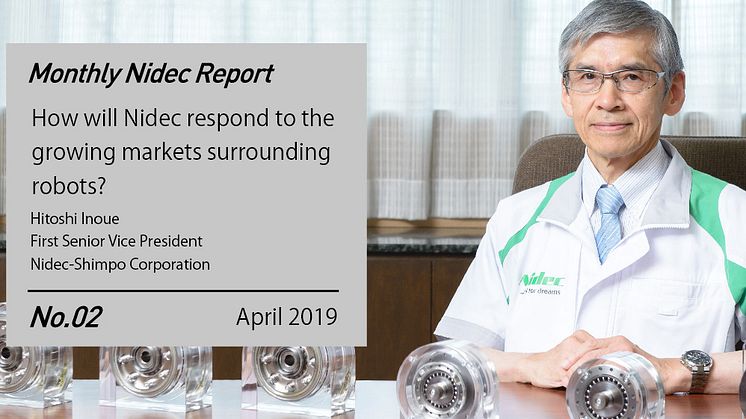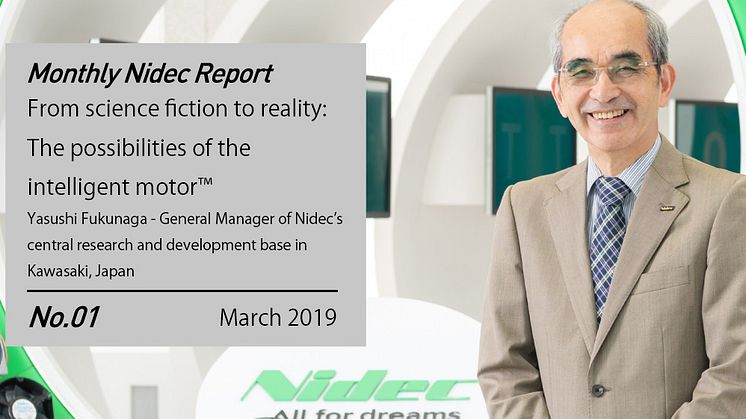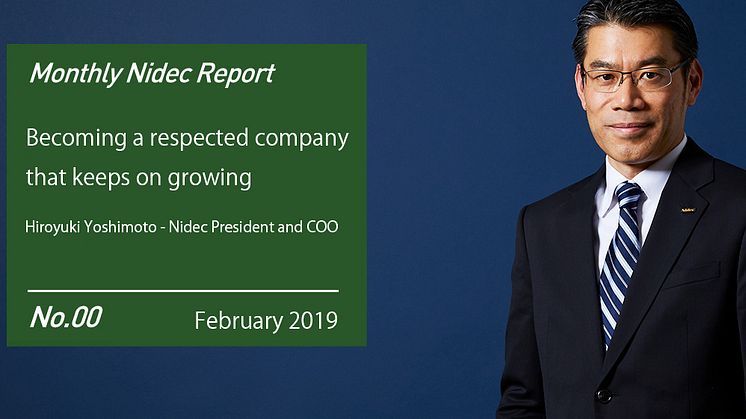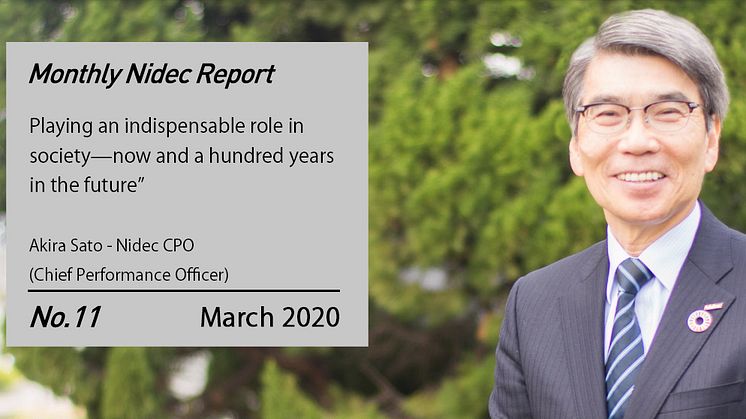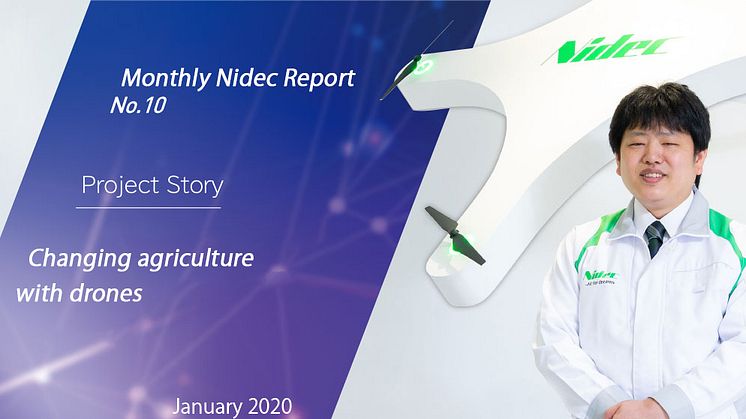
Blog post -
Monthly Nidec Report - Changing agriculture with drones
The need to save labor and boost productivity in Japan's agricultural sector has become an urgent issue due to the aging and decreasing farming population. Set against this backdrop, Yamaha Motor's agricultural spraying drone launched in March 2019 is gathering attention as a possible solution. The company, which has captured the largest share of the global market with its unmanned agricultural-use helicopter developed over 30 years ago, now stands to transform agriculture with its first agricultural drone.
Among the technologies that made this drone possible is a compact and lightweight motor jointly developed by Yamaha Motor and Nidec—the first Nidec motor for industrial drones that has successfully been commercialized. In this article we interview Tsuyoshi Nakagawa, one of the young developers who worked on the motor, about the difficult development process.

According to statistics published by the Japanese Ministry of Agriculture, Forestry and Fisheries, the country's farming population has fallen from 4.82 million people in 1990 to 1.75 million in 2018, while the average age of farmers in Japan has risen to 66 years. As a result, unmanned helicopters, most of which are made by Yamaha Motor, have come to be used for almost half of Japan's rice crop acreage. Yamaha Motor’s agricultural spraying drone YMR-08, a compact and relatively inexpensive agricultural drone optimized for urban area farming and small-scale individual farmers, is the result of the expertise and experience that the company has amassed over the 30 years it has been offering these helicopters.
The YMR-08 is capable of spraying an area of 1 ha in a single 15-minute flight and the sprayed pesticides and fertilizers are dispersed, and reach the roots, evenly. Furthermore, the low cost of the drone—a fourth of what an unmanned helicopter would cost—makes it a reasonable and affordable solution.

The joint development of the motors powering the drone started after the Nidec group approached Yamaha Motor with a proposal based on a prototype of a drone motor designed by Nidec's central R&D hub in Kanagawa and developed by Nidec Servo. Yamaha Motor responded positively to the high accuracy and stable quality of the prototype. Nakagawa, an engineer who has been with Nidec Servo for 8 years and who was tasked with analyzing and evaluating the performance of the prototype, recalls the excitement he felt at the time. "Personally, I wanted to be part of the development of drone motors so I was exhilarated when I understood that we might be looking at a joint development project with Yamaha Motor—the leader of the global market for agricultural-use helicopters. "Nagakawa had a personal connection with Yamaha Motor as their head office is located in his hometown: Iwata in Shizuoka prefecture. For Nakagawa, working together with Yamaha Motor, a company that had been familiar to him since he was a child, on a cutting-edge project in a new field was a welcome opportunity.

In recent years, drones have been receiving more and more attention in Japan, and, in the time leading up to the joint development project, Nidec was in the process of launching development of industrial-drone motors based on the technologies the company group has gained in the automotive and IT fields. At the same time, Yamaha Motor was looking to develop an agricultural spraying drone that would set the company apart from its competitors."Our needs aligned and we were off to a good start.” However, the project was not without its challenges. "I vividly remember thinking to myself that 'this was going to be really difficult'," Nakagawa says.

The biggest hurdle to overcome was reducing the weight of the motor. In order to maximize flight time, the motor would have to be as light as possible, so Yamaha Motor set a target of 350 g—less than half the weight of the 900 g prototype. That being said, it was common knowledge among the team members that extreme weight reduction would be required from the outset. “Mr. Nagamori, the founder of Nidec, had impressed on us the importance of weight reduction. At about the same time as the project was about to start, he told us that ‘motors will inevitably have to become lighter from here on; Nidec's drone motors in particular will have to be lighter than 190 g. ’350 g drone motors made by pioneering Chinese companies had already reached the market so we were eager to develop a world-class drone motor that would befit a company styling itself as the world's No. 1 comprehensive motor manufacturer. "This became the start of a struggle to "trim the fat" of the motor in pursuit of ultimate lightness.

“The heaviest part of the motor is the core with the coils that generate the magnetic force that drives the motor. Therefore, we opened up a large hole in the middle of the motor core. It looks quite a bit different from a regular motor”, Nakagawa explains. However, although this makes the motor lighter, it also makes it more difficult to design a sturdy and powerful motor.
The project was set up so that the Yamaha Motor engineers were responsible for the fundamental shape and design of the motor, while the Nidec engineers were responsible for the motor’s performance. Whenever an issue would arise, the two groups would consult with each other and combine their expertise to solve the problem. "The Yamaha Motor engineers were adamant that we design the motor to be as light as possible. They would tell us during meetings that every small weight saving, even as little as 0.1 g, would count, so we launched into a process of trial and error, analyzing different materials and making various propositions. We continued looking for ways to remove weight from the motor without compromising its sturdiness until the very end when the specs of the mass-production model were decided upon. As a result, we arrived at an optimal high-output design—a hollow aluminum-reinforced construction with a large diameter.
 The team members in Nidec’s central R&D hub in Kawasaki
The team members in Nidec’s central R&D hub in Kawasaki
However, there were major setbacks as well. During the latter part of the project, when production of 600 flight-test units had just started, there was a phone call from Yamaha Motor: the rotor had broken during testing. The motor core had been too weak and the motor's durability had been compromised. After promptly amending the design, the crisis was averted, but the incident served as a reminder that unexpected things can happen during unprecedented development projects. "The Nidec Research and Development Center—Nidec's central R&D hub in Kawasaki—with its motor-technology-related expertise proved useful in overcoming these challenges," Nakagawa recalls. "I realized that one of Nidec's strengths lies in our wealth of capable engineers who can analyze the root of issues and their results."

Naturally, a motor used by an agricultural drone would need to be able to withstand agricultural chemicals, but neither Nakagawa nor the other Nidec team members had any previous experience with materials resistant to such chemicals. We knew that the materials and the coating would have to be resistant to oxidation since the motor was going to be used in an outside environment, so we started by searching for rust resistant material and surface treatment specialists. We were able to find a surface treatment company that would work with us, but finding the right material proved more difficult; it turned into a cycle of trial and error. ”The team considered many different materials and studied the effects of agricultural chemicals on the rustproofed surface. In the end, it took six months to find a material that was resistant to both rust and chemicals.

There were other requirements that needed to be fulfilled as well. For example, it was necessary to prevent potentially damaging heat generation. One way of doing so would be to use low-resistance thick winding wires for the coil. On the other hand, however, using thick wires would make the motor less powerful as the number of windings would decrease compared to a motor with thin wires. A solution that could solve these two conflicting issues would have to be found. How could the team succeed in making the wires thick in order to minimize resistance while, at the same time, maximizing the number of windings in order to make the motor as powerful as possible? The solution that the team arrived at after spending a lot of time discussing with the production engineering group, was to increase the precision of the winding process. "Although a bit of a brute force solution, by making the wires as thick as possible while also precisely controlling the winding process we were able to maximize power while minimizing heat issues," Nakagawa said with a wry smile.


In order to guarantee precise winding, the process would have to be automated. "The winding has a large impact on the quality of the motor. Apparently, one of the reasons why Yamaha Motor chose to work with us was that the construction of our prototype made it possible to automate the winding process. "The unique construction, resembling a row of sewing machine bobbins, was developed by Nidec Servo based on an idea conceptualized at the Nidec Research and Development Center. Leveraging this design and automating the winding process would result in a significant advantage in terms of stability in quality and productivity over competing hand-wound motors. "Yamaha Motor wanted a safe drone with a motor that would not break down even if driven a bit carelessly and pushed to the limit. In order to guarantee that kind of reliability, it is necessary to iron out unevenness in product quality."

In the summer of 2018, the release date of Yamaha Motor's agricultural drone was announced, and a sense of urgency started to set in among the team members. Development and deployment of automatic winding machines was proceeding concurrently with the development of the motor, and Nakagawa visited the factory in Vietnam where the motor would be mass-produce to evaluate the performance of the equipment.

"A variety of small issues occurred during the mass-production preparation phase as well, but as soon as a problem arose we investigated the cause and resolved it, so I have confidence in the degree of perfection," Nakagawa says. True to these words, the performance of the motor puts it ahead of competing products. In addition to achieving world-class efficiency, the team was also able to reduce the weight of the motor to 260 g, far below the initial target of 350 g.
Mass-production proceeded smoothly and before long the agricultural drones with the new motors started arriving to farms. "As the drone sees more and more widespread use, it makes me happy to think that we are contributing to reducing the workload of farmers."

"Looking back at the project, it feels rewarding to have successfully overcome such a challenge, but during development there was no time to rest our minds. Even still, the thought that we were contributing to a new age of industrial drones with our motor technology kept us motivated," Nakagawa says. So far, the response has been very positive. After the motor reached the market, many potential customers have contacted Nidec, one after another, to inquire about a wide range of possible applications. "We managed to break into the drone motor market, so the next step will be to pitch our products to the dominant Chinese players in the field and contribute to the growth of the market. Industrial drones have many different applications. In addition to spraying agricultural chemicals, they can spread fertilizers, plant seeds, and if you equip them with cameras they can monitor the growth of crops as well.Other uses include applications in logistics such as delivery services, and filming and measurement at construction sites.”

The industrial drone market is growing as new applications in a variety of different fields pop up. According to a study by Yano Research Institute, the drone market is expected to grow to a size of JPY 2T in 2020."Our goal is to leverage the experience that we gained through this project and contribute to society by supplying Nidec motors for use in industrial drones in all kinds of fields."


Drones have quickly found their way into a wide variety of applications, but most products in use are hobby drones. From here on, when the market matures, the demand for user-friendly drones that offer convenience to general consumers in practical situations is likely to rise. Thus, we set out to develop an easy-to-use and effective drone that would meet the expectations of farmers. We aimed for simplicity in all of the components—motors, batteries, control systems and the body of the drone.
In terms of cost competitiveness, Nidec's motors are capable of standing up to the Chinese products that have captured a majority of the market. Furthermore, their production technologies afford them a lot of flexibility and allow them to develop fit-for-purpose manufacturing techniques, even for new products that they do not have any previous experience with. This played a large part in our decision to work with them on the development of the motor. The teamwork between Nidec's developers, designers and different research facilities felt very strong and contributed largely to the unprecedented quality of the motor. This tight teamwork and Nidec's corporate culture of never saying that something cannot be done left a positive impression. I look forward to seeing if they can develop an even lighter and stronger drone motor in the future.By doing so, new possibilities for drones might even open up.
